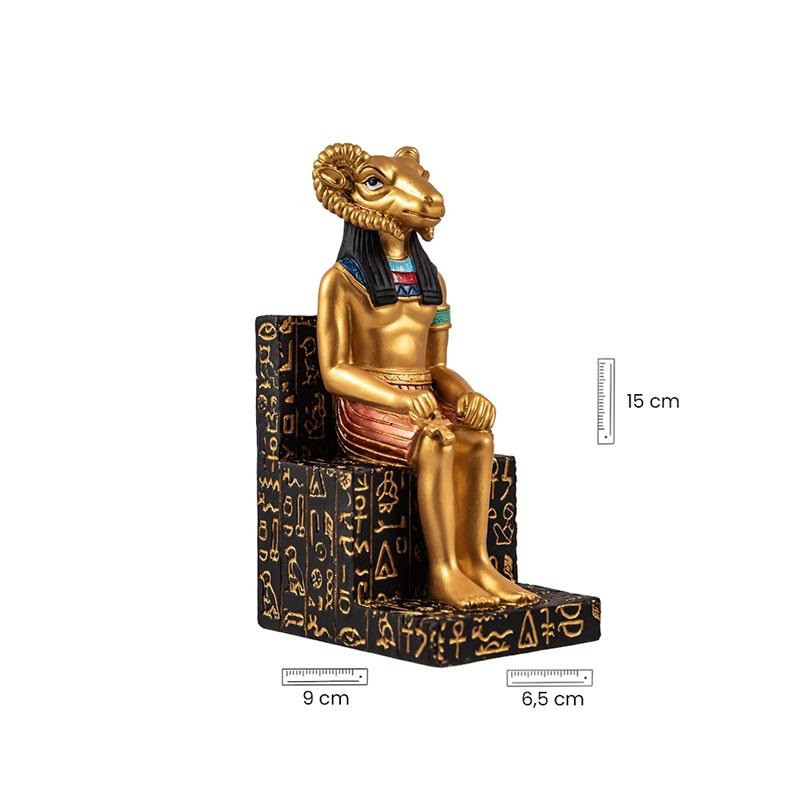








Image of Amon
Size: Approximately 15 cm tall.

Security policy

Delivery policy
Being also called Ammon (venerated in Greece) or Amun, among others, its name means hidden. Or nome justified by being the deus of wind and atmosphere, being omnipresent despite being invisible.
In Hermopolis we consider the member of the ogdóade (a set of primordial gods that emerge from nothing, before the gods of the Sun are created; Amon and Amaunet symbolize the hidden power, Kek and Kauket a escuridão, Heh e Hauhet o infinity and Nun e Naunet o primordial abyss). He was married to Amaunet, and was born from this union Chons (ou Khensu), or deus da Lua. Amon was born with Mut, in Thebes, and with Chons formed the triad of this city.
Tornou-se later, in the 11th Dynasty (2133 to 2000 BC), the Sun deus venerated in Thebes, in the capital at this height. He was given the name of Amon-Rê (deus of the Sun) and ended up becoming the most important deus of the Egyptian pantheon and protector of the pharaohs, in whom he incarnated. Vogava hair céu numa barca, which during the night dawned the night of the underworld.
It was by a political quest that Amon became one of the two most cultured gods in Ancient Egypt.
In principle, the deus Amon was a local deus. He was worshiped in the city of Thebes along with his feminine version, Amonet. Both are part of the Ogdoad, or pantheon of Egyptian deities that existed before the very formation of the world. It is part of the original pantheon of deus Rá, creator of the world.
Around the year 3000 BC, Amon did not enjoy a special preference from the Thebans. What everything indicates, the cult of Amon gained importance after the victory of Amósis I against the Hyksos, who had invaded and assumed or controlled the Lower Egypt. Pharaoh Amósis I was responsible for reconstituting the unity of the Egyptian Empire in the year 1580 BC.
The pharaoh attributed important victory over the Hyksos to the divine aid of Amon. During the New Empire (which lasted from 1580 BC to 525 BC), Amon had its apogeu.
This ascension was consolidated by the fusion of Amon with Rá, the ancient god of the sun and creator of the universe. Under the name of Amon-Rá, he incorporated the solar attributes of Rá, becoming an even more powerful and revered figure.
Amon-Rá turned into the supreme god of Egypt, associated with creation, with royalty, with victory, with fertility and with the sun.
This fusion of Amon and Rá has a profound impact on Egyptian society. It represents the unification of the Empire, strengthening the power of the pharaoh and legitimizing his divine authority.
There are countless powers that Amon has indefinitely incorporated over two years. Let's look at all the facets of Amon-Rá:
Deus do Sol: let us call Rá é a solar divindade. The Sun is a nurturing element, which is responsible for giving life.
Deus creator: he was not only known as the deus who created the world, but rather that he created himself. One of his epithets was "Amon-Rá, or Self-Crafted".
Deus da fertility: a deus breeder, like Amon-Rá, is automatically a divindade linked to fertility.
God of war: just as he did with Rá, Amon also absorbed the power of war from the ancient deus Montu. Due to this belief, Amon-Rá was frequently invoked during battles.
Deus onipresente e tierra: another interesting fact about Amon-Rá, second to belief, é que este deus, ao contrario de other divindades, fazia-se present aqui e ara. There was no distance between Amon-Rá and the world of two men. As it happened, Amon-Rá was completely separate.